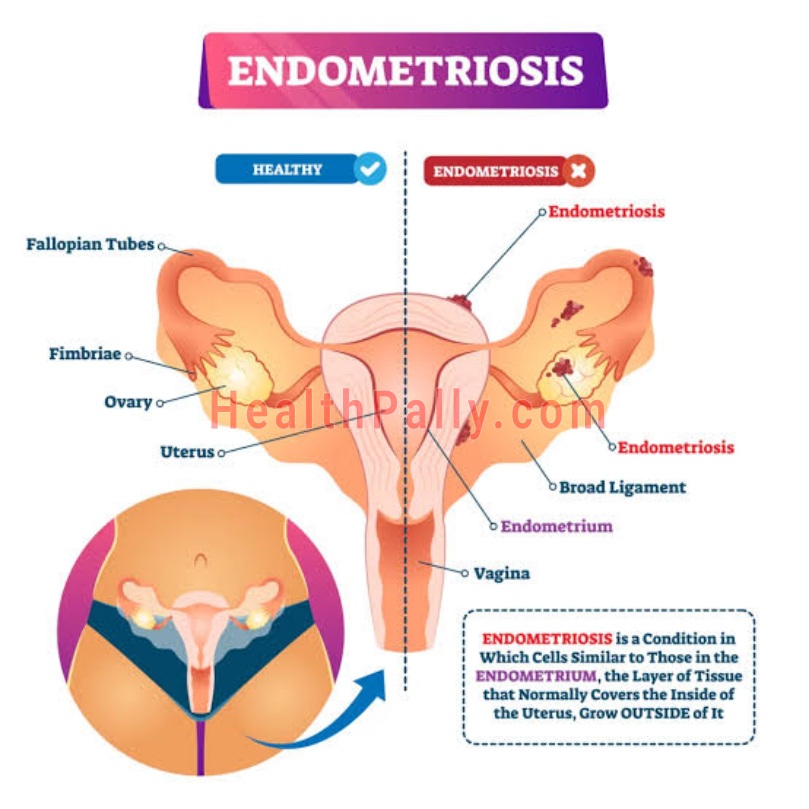The abnormal growth of uterine tissues is termed as endometriosis.
It appears similar to that of lines inside the uterus, however, it appears outside the uterus.
Endometriosis is the condition where the uterine line is observed outside the uterus in the abdominal cavity.
Endometriosis while responding to Estrogen can cause pain during the menstrual cycle, chronic pelvic-back-hip-leg pain, infertility, and pain during sexual intercourse.
Endometrial tissue is shed every month during the menstruation.
It is not necessary that all women experience the same symptoms of endometriosis, some do have different symptoms.
Symptoms
Most of the women who are suffering from endometriosis do not observe symptoms.
However, some of the common signs of endometriosis are pain while urinating, having sex or when having a bowel movement.
The intensity of the pain can differ from month to month. The same pain can differ greatly with affected individuals.
There are low chances of getting pregnant with mild to severe endometriosis.
It has been seen as one of the reasons for infertility among healthy couples.
When you feel some of the symptoms mentioned, the first and best approach to treatment is to go for laparoscopic test.
In some patients, it can take a long time to get pregnant with endometriosis if not detected early.
Studies even state that patients who are suffering from this disorder are likely going to suffer from ovarian cancer.
Women suffering from endometriosis and infertility will have a high risk of ovarian cancer.
Endometriosis Stages
This disorder has been classified into four stages, namely minimal, mild, moderate, and severe endometriosis.
When a woman is at the mild stage, then she should go for laparoscopic surgery for endometriosis and can be done in a couple of times.
Sometimes, there could be a pain again after three months of the surgery.
At the severe stage, endometriosis can not be treated with laparoscopy again but hysterectomy.
In some cases too, it can come back after pregnancy as it’s almost lifelong in most patients but can be very manageable.
In a few cases, the pains can come back years after a hysterectomy, after pregnancy or even after menopause, so the best thing is to go for the test as the early stage of the disorder
Diagnosis
Endometriosis involves surgical analysis as the stages can progress relatively fast if not detected early and controlled.
The disease can not be diagnosed by physical examination, and with the patient history, blood test urine test, X-rays, ultrasound, CT scan, and MRI.
The disease is diagnosed with laparoscopy by the physician. The laparoscopic test is conducted to evaluate the condition.
Laparoscopic excision is better as it will provide better diagnosis which is a tissue diagnosis.
The scenario is observed where the lesions may not have the symptoms of endometriosis, however, it may not be confirmed by a pathologist.
On the other hand, the conditions may not appear like endometriosis for the person and the pathologist will not confirm it.
Therefore with laparoscopic excision, the individual will get to know what the patient has instead of labeling them without knowing the disease.
Some treatment diet plans, recipes or new drugs may help but surgery would help in managing it.
However, there is a newly developed endometriosis blood test that costs about $300 and has proven to detect 90% of the cases.
Treatment
when the patient is found to have endometriosis after the physician observing the abdomen in the laparoscopy, the doctors can try to destroy the lesions or the areas of endometriosis can be excised.
Once you’ve been tested positive to this disorder, you need to avoid foods with high fats and cholesterol.
Endometriosis invades deeper into the tissues, pains may come back and the patient can have laparoscopy surgery repeatedly.
Excision gives the best chance for long-term pain relief and minimizes the need for repeated surgeries.
During surgery, the physician may treat the lesions that are visible and there may be lesions that are not reachable to sight.
So, laparoscopic excision is the best way to treat endometriosis.
Laparoscopic excision enables to excise all the areas of the suspected endometriosis completely down to normal tissue with adequate margins and all specimens are sent to pathology for confirmation.
Excision gives complete relief from pain and reduces the need for surgeries.
